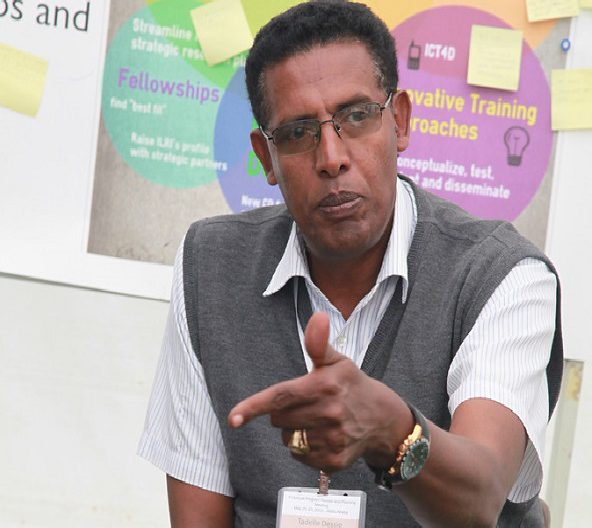
BY DANIEL ALEMAYEHU
Tadelle Dessie is a principal scientist at ILRI and adjunct professor in Animal breeding and genetics at the Bahir Dar University, Ethiopia. He has more than 30 years of experience in the field with a long track record of research on poultry and livestock breeding and genetics. As a project leader/PI of DAGRIS, ACGG, AsCGG, and TPGS led the design and implementation of the projects. He joined ILRI in 2004, and he is currently a Principal Scientist and a member of the Global Livestock Genetics (LiveGene) program at the International Livestock Research Institute (ILRI).
His publication and project management record demonstrates his ability to undertake, plan and manage multidisciplinary research in livestock genetics and breeding research and development. He is responsible for coordinating the design and implementation of project activities in collaboration with partners and project reporting. He supervised and co-supervised more than 30 Ph.D. students. In consultation with partners, the PL is responsible for researching and providing alternative approaches. He is also responsible for designing and developing several chicken breeds in Africa, leading the sourcing of tropically adapted chicken lines, and developing material transfer agreements between owners of the chicken lines and ILRI. All the project team members from different geographies report to him.
First of all I would like to thank you on behalf of our readers for spending your precious time. What is the current status of Ethiopian livestock resource?
Well, if we take the livestock population, yes, Ethiopia is the first in Africa and ninth or tenth in the world. This is just a number. This does not have any connection with the economy and its benefits for the people. But the number shows that we are listed first in Africa, and ninth in the world. Regarding the resource, we are much better.
Do you think we are using our rich resources effectively?
As far as I am concerned, I do not think that we are using our livestock resources effectively. We could have used it in a much better way than the current trend. There are multiple reasons why we are not using them effectively. One of the main reasons is that our farmers both in the highland and lowland areas raise animals for different purposes. It is not for economic gains or to produce livestock products.
For instance, in the highland areas, farmers rear cattle for nurturing farm oxen. This means that they need to increase the number. They do not focus on the productivity. What if we start to plough our farms in a mechanized way? We do not need that much number for increasing the productivity rate. With small number, we can produce more to feed our people. As I told you earlier, the purpose of the farmers is not to yield meat and dairy products. Animal traction is the core reason. Therefore, we have not obtained what we should from our livestock resources.
Most of the livestock resources are in the hands of our farmers. What kinds of actions have been taken to aware farmers? Do you think our farmers get enough support to use their resources?
You know, our agriculture is in the ceteris paribus circle. It does not escape from this cycle. It means the farmers have the livestock. They use the resources not only for meat and dairy production; the farmers use them for traction too. Therefore, he/she should increase the number of the livestock. When the number of the livestock increases, the farmers will have little or no extra yield. When the farmers have no extra yield, they will not have much product for the market. For this reason, the farmer has little or no money to invest or reinvest on other things. The income again will be used for the same livestock. The farmer shuttles to and fro in this circle. This is the first problem.
The second problem is that our farmers are not market- oriented. This time, the concept of selling livestock products becomes growing, but in the minds of most farmers, this concept is not established. If we assume that the farmers are market- oriented, the consumer, found in the cities, is not purchasing the products due to their extortionate prices. Now a days, even drinking a glass of milk becomes luxury.
In the push and pull system, when the market pulls the demand, farmers strive to produce the necessary products. In our current market, there is no pull factor. On the other hand, the Ministry of Agriculture pushes farmers with multiple trainings and awakenings to produce and uplift the productivity level. There will be no change by pushing the farmers to meet the limit unless there is a pull factor from the market. We need to work hard to run away from this circle.
Furthermore, our investment needs to be seen. As we know many investors come to Ethiopia. Even multi-millionaires want to work and scale up the sector. They also enquire about investment opportunities. Many of them came with higher drive to work and change circumstances. They also ask about the budget and other preconditions to start working in the sector. After these all questions, they ask about the return investment. When they know the fact about their profit, they start looking for other sectors specially trade and hospitality. We could not attract investors who would work harder and confidently start to work in agriculture.
Let me give you an example, when I was a student, getting a rose flower for your lover was difficult. And now, you can get flowers anywhere. The reason was that 15 – 17 years ago, the government prepared an exclusive package for investors who wanted to work on the flower industry. For the investors, land and loan queries were answered within short period of time. The necessary materials were imported free. These were the incentives for those investors from the government. Due to such pressure from the government, the country is now filled with flowers. Such revolutionary decisions are needed in the livestock sector.
According to USAID 2021 report, almost all of the Ethiopian livestock are indigenous. Is Ethiopia advantageous regarding the indigenous breeds or not? How can we secure the patent right on Ethiopian breeds?
It is true that 99 percent of Ethiopian sheep and goats as well as 95 per cent of the cattle are indigenous. Our breeds are unique and have their own qualities. A simple illustration, with such bad fodder and low quality of food, our breeds can give at least little products. With this quality of fodder and loads of diseases, other breeds have no other choice than death. That is why we say our livestock have their own qualities. They are resilient and adaptive.
Genetically, our livestock breeds are of high quality. This is our responsibility to study and document these qualities of our breeds so that when the question of patent is raised we should explain everything about it. It is our responsibility.
A number of researches have taken place. These studies focus on genetic characterizations and on the whole Ethiopian livestock genetics. We believe that we are succeesful so far. A study has been undertaken on every Ethiopian livestock. We have also published a book on these issues. This book is found at Ethiopian National Museum. This depicts we have documented everything regarding Ethiopian livestock every quality. Maximizing productivity is the next step we will take.
Moreover, practices were implemented to uplift the livestock in different time frames. For instance, there was a ranch in Adami Tulu. It was established during the reign of Emperor Haileselassie I and continued throughout the DERG military regime. This ranch has been a place for studies on maximizing the productivities of Borena cattle. Various actors and stakeholders were involved in the study, and they achieved many improvements on the cattle.
However, when the Derg regime was toppled, the people destroyed the ranch and slaughtered the cattle for food. That day the people destroyed genetics. This ranch is not the only one; there are different study areas in Bahir Dar and Wollega. In these studies, most of them lack continuity. Inconsistency of the government’s investment focus is also a challenge. Every season and every year, government’s priorities differ and the budget might be allocated to different areas.
Therefore, we can say that we are advantageous that we have indigenous breeds, but it should be supported by productivity improvement. Our farmers have plenty of questions that need to be answered regarding livelihood. As a result, better productivity and conserving the indigenous breeds should go together and equally. Our advantage of having indigenous breeds should go with improvement.
In many occasions, we heard about informal trading especially in boarder areas. What actions have been taken to alleviate this problem?
I believe that it is still easy to halt informal trade. On the other hand, Ethiopia has vast borders in every corner. For instance, when you ask a farmer from one of the border areas to sell his livestock in Addis Ababa, you need to answer the questions of proper transportation. Again, we need to have proper market with proper price. Unless we meet these preconditions, it will be impossible to get what we want. We may present statistics about losses from informal trade, but we have our own homework to do. We need to focus on our duty, and then we will be successful.
It is true that farmers still use traditional ways to rear livestock. On behalf of the entire stakeholders, what has been done to modernize the whole system?
We have been working with responsible stakeholders especially with the government. We have supported the government on areas of strategic importance. For instance, ILRI and the Ministry of Agriculture, have designed a 10 years Livestock Master Plan. The government is implementing this master plan. Not only this, we have also finished working on the 10 years poultry development strategy. There are also big strategic supports.
Likewise, I think there should be government supported strategic transformation on the macroeconomic level. This is beyond ministry of Agriculture or other stakeholders. The mandate is on the government. The whole agriculture setup should
be transformed. Currently, we are listening to news on cluster farming and mechanized farming. This action will definitely help the livestock sector. It is because farmers start raising quality breeds for specific products such as cattle for meat or milk production. This time, the productivity hits the highest. Everything is interconnected.
Regarding nutrition benefits, are the people of Ethiopia getting the right nutrition benefits from the country’s livestock resources?
Of course, the children get what is needed in their first 1000 days. But it is not enough. Based on World Health Organization and World Food Program set criteria, our children do not get what necessary livestock nutrients. For the above reasons, there are initiatives that are endorsed by different international organizations and the Ethiopian government. These initiatives are even become declarations like Seqota Declaration. The declaration commits to eradicating the underlying causes of chronic under-nutrition and ending stunting among children less than 2 years by 2030. This declaration is like a commitment for us. To meet our objectives, we should be productive, and those who are living the lowest living standard must also afford the products.
Currently, there are conflicts in different parts of the world. Do you think the current world’s situation affects Ethiopian livestock?
Definitely, those conflicts affect the country directly or indirectly. In Ethiopia, there is enough production and productivity. In this case, the challenge is that the annual growth of production and productivity of the country is not equal to the population
growth. The production rate does not match the population growth rate.
Regarding export, do you think we react on the local demand before exporting our livestock products?
In this case, the export products are different from the products needed locally. For instance export sheep and goats are very lean; rather the sheep and goats for the local market are fatty. The second one is that though it is profitable to sell products in local markets, we export them for hard currency. The local demand is high.
Can you point out the major challenges that the livestock sector has been facing?
Firstly, we need to work on the quality and quantity of our feed resources. Second, we need to work highly on animal health. We need to have healthy animals to produce healthy products. In addition, private health service providers should be involved. We also need to work on genetic development and improvements. Above all, we need to create conducive market linkage. We need to have proper market linkage throughout the country. Unless we create such system, we might end up losing what we have in hand. We might create informal trade system. The other one is that we do not add any value on our products. So the market chain is needed.
Besides, our land policy should be assessed, too. Livestock and livestock products are perishable. Infrastructure should be fulfilled to support the investment. To improve the livestock, there has to be different packages to help investors.
Most of the companies are achieved under their capacity. They cry out for enough livestock with desirable qualities. In the contrary, the pastorals say that they do not have the market. Something is wrong. That is why we need the market chain.
Last but not the least, with all the problems, what kind of improvements or development do we expect in the future?
If we start using modern machines and start mechanized farming, the farmer will start thinking about quality rather than quantity. Having improved and flawless land policy will pave the way for better production.
Do you have anything to add? The stage is yours.
Our agriculture is tuned in producing wheat and maize, and all the news are on them. The budget, manpower, and everything channeled to it. It is good. One thing our policy makers, the government, and the people should know is we can buy wheat by selling milk or meat.
Thank you very much!
My Pleasures
The Ethiopian Herald April 16/2022





